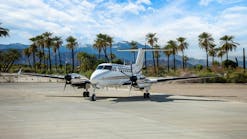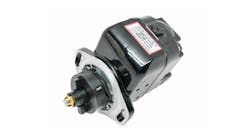Lack of Resources
By Richard Komarniski
July / August 1998
Commonly accepted definition of an Aircraft Maintenance Technician: "A person who has learned to do more and more with less and less until they are fully qualified to do everything with absolutely nothing." Does this sound all too familiar?
Let's review a case study that will help to illustrate the importance of having the proper resources. The Piper Navajo was one of the more high time aircraft in the fleet but was generally well maintained. The crew had been complaining about a "Door Not Closed" light coming on in flight, but it always appeared to function correctly when maintenance personnel tried it on the ground. Since the latch was worn, maintenance management personnel decided to order new parts to be installed during the next 100-hour check. The parts were not designated as AOG'd (Aircraft on Ground) and they had not arrived when the 100-hour check was performed. The aircraft was signed out as "return to service." Flight crews noticed that the door light was coming on more regularly and could be activated while the aircraft was on the ground if you pushed on the door. Still, no parts had arrived (the factory was going through a bankruptcy), and the aircraft continued to fly. One day, a lady sitting near the door complained of a draft and noise from the door. The co-pilot left the cockpit to check on the door and just as he reached to check the handle, the door flew open. He fell out of the aircraft, but his legs had become caught in the strap used to hold the door when it was opened. The co-pilot was looking down at 3,000 feet between him and the earth — his feet held by a strap, and no way of getting back in the aircraft. The pilot made an emergency landing with the co-pilot dangling and looking at a runway just inches from his face, on touchdown. There were no physical injuries, but plenty of adrenaline was flowing that day in the aircraft. Another pilot, who was flying single pilot in the same type of aircraft, was not as lucky. Setting the autopilot, he went back to check on the door and disappeared, never to be found.
What can we do about incidents like these? In the case study, there were a few options. The latch was giving lots of warnings that it needed replacement. It should have been replaced even if it meant the cost of AOG-ing the part, or calling around to locate the correct part, or grounding the aircraft until the correct part was located.
Parts are not the only resource we need to do our job properly, but all too frequently parts become a critical issue. We can try to be proactive by checking suspected areas or tasks that may require parts at the beginning of the inspection. We can AOG the required parts, or order and stock anticipated parts before they are required. We can also work at establishing available sources for parts and arrange for pooling or loaning in order to meet critical shortages.
Making sure that we have the correct tools for the job is just as important as having the proper parts when you need them. And, having the correct tools means not having to improvise. Recently, an aircraft manufacturer was weighing an aircraft (which had received a new interior) prior to releasing the aircraft for an air show. Two days before the planned flight, the aircraft was weighed without the proper electronic load cells placed between the aircraft jack and the aircraft. You guessed it—the aircraft slipped off of one of the load cells and the jack point creased the spar. If we improvise, what can be the potential cost? We need the right tools to do the job and if they are broken, out of calibration, or missing, then we need to get them repaired, calibrated, or returned as soon as possible.
One of the most common lack of resources we face in our industry is adequate lighting for the task at hand. AME/A&Ps often depend heavily on flashlights perched on some part of the aircraft to carry out a task when only a few meters away is a proper portable light. How many times have you seen a fellow worker do an inspection in a wing, take out 56 screws; drill out 6 of them, replace 2 anchor nuts, and then spend 5 seconds looking inside the wing with a single-cell AA pen light? What are they really going to see with such a light?
Colin Drury from the State University of New York at Buffalo found that most maintenance facilities were lit to 51 foot-candles of light (ft-c). In his studies, he recommends a minimum of 75 ft-c, with critical inspection situations requiring a minimum of 95 ft-c. He also found lighting requirements double with age. For example, for a 25-year-old technician 50 ft-c of light may be sufficient while 100 ft-c of light may be required by a 55-year-old to perform the same task.
Technical documentation is another critical resource that can lead to problems. When it comes time to find out more about what we are working on or how to troubleshoot and repair a system, sometimes we cannot find the information we need in the manuals or diagrams in order to complete the task. If we cannot find the information we need, we should feel free to ask a supervisor, or speak with a technical rep or technical publications department at the appropriate aircraft manufacturer. Most of our manuals are in a constant state of revision, and, if you do not identify missing information in the manuals, then nothing will be done to correct the documentation. The publications department relies on your feedback. Some manufacturers have technical support people available by the phone 24 hrs a day to answer your questions. They are a valuable resource, use them. Do not put yourself in the position of having to make decisions on your own without the proper documents to support your decision. Resources are there to help you, so use them.
The final and most valuable resource you can have in a maintenance department is the flight crew. All too frequently, the level of communications between the flight crew and the maintenance crew is extremely poor. The flight crew can provide us with all sorts of valuable information when dealing with a defect. This information includes:
•When and where the event occurred • Indications prior to failure
•Did the system surge or flicker?
•How often does the system cycle?
•Range of transmission or reception
•Time of retractions or extensions
•Noises in aircraft, in the headsets, etc.
•Vibrations, stiffness of system
•Was irregular trim required?
•Ease or lack of control
•Smoke or fumes
•Loss of amperage and/or voltage.
When I have worked with various aviation maintenance departments, one of my first goals was to build a rapport with the flight crews. Again, this is not the first thing most maintenance personnel think of doing. I showed them that I was very interested in how the aircraft performed and was interested in all of the small defects as well as the big ones. I wanted details. The more they told me, the easier my job was to troubleshoot and less time was wasted. The flight crews always called me on the radio when there was a defect or if they thought I may want them to do some troubleshooting on the ground before they shut down the engines. The result was that most problems were fixed the first time around. The company saved money and made money because we worked together.
When we have the proper resources for the task at hand, there is a much higher probability that we will do a better and more efficient job. And, there is a higher likelihood that the job will be done correctly the first time. Learn to use the resources that are available. If the correct resources are not available, then make the necessary arrangements to get them in a timely manner. The end result will save time, money, and of course, enable us to complete the task knowing the aircraft will be airworthy from all aspects.




